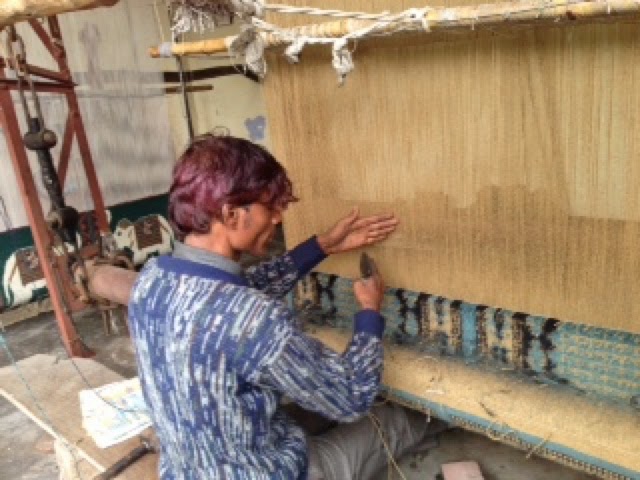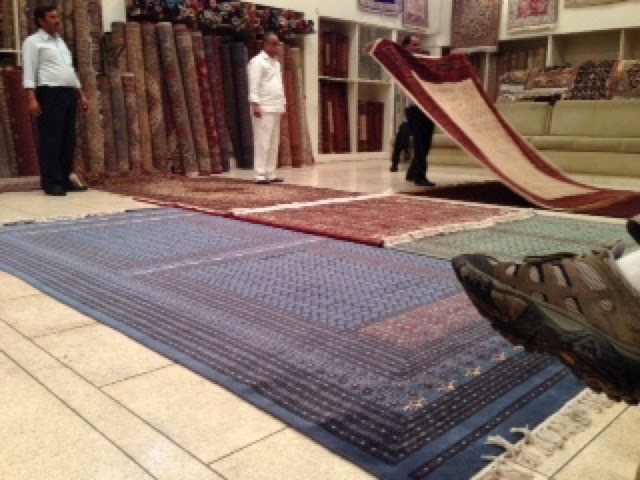Hawa Mahal in the pink city of Jaipur, Palace of the Winds, a facade of 956 honeycombe windows used by the ladies of the palace to watch the outside world without being seen, a must see in Jaipur.
This is an amazing several story building with 956 latticed windows in the pink stone color of the inner city. This is where the women could watch the outside world without being seen. We got to see this several times as we passed through the city. this central area, which is very large, is all the same color sandstone.
Sheesh Mahal, or Hall of mirrors, at the Amber Fort where harem dancers held candles and performed for the Maharaja.
We went around the local market of Jaipur ( Bapu Bazaar) experiencing the colors,sounds & smells of India.
The day was raining on our way to the Amber Fort, so we were unable to hike to the gate. Dev arranged for 4 wheel drive vehicles. We did not take the traditional elephants, although some other tourists did. It looked pretty wet. But OAT does not endorse this because of the controversy re how the elephants are handled.
Then the rug is washed in a solution of some kind of chemical and rinsed a lot, using a wooden squeegee like pole. Water is poured over and over again before it is left to dry in the sun for several days.
Drums greeted us at the entrance and public courtyard, while we watched the wet people entering on the elephants. The next area is the private court which has the famous hall of mirrors, called the Sheesh Mahal. Dancing girls would dance here for the Maharaja by candlelight. It is roped off as you would expect since the mirror, or shiny metal? work was amazing. Then off through another arch into the Harem area. This looked twice as large as the first two areas. Most of us huddled under a covered area in the central courtyard, but some explored as I did the small rooms and passages that twisted and turned and entered another courtyard or passageway which was too narrow to accomodate my super small umbrella. It continued to rain even though we waited for it to let up before we exited. Dev managed to get us the 4 wheel drive cars to pick us up close to the exit in an area prohibited to vehicles.
We Amber fort
View from above
beautiful gardens
Hall of mirrors
We stopped at a craft coop that sells block print fabric and hand knotted carpets. We were given a demonstration of each. The three dyes they put onto a piece of cotton each had a different cutout stamp. The colors frankly looked the same and I thought it would look bad, but oh well, that is the way of their art. But all you have to do is put it in vinegar water and vibrant colors are revealed. He did an elephant and a peacock pattern for us and gave us the swatchs.
Block printing
Next we saw the whole process of making a wool oriental carpet. Families have looms in their homes. Someone works on it for a couple hours only at a time because it is hard work. You take a small length of naturally dyed wool and twist it between the long strings, Keep doing this for the whole row keeping the pattern. Then tamp it down and move the strings.
The next step is turning the rug over and blowtorching the back to singe off the tiny hairs that are left and make a smooth reverse side of the rug.
Washing with wooden paddle
Then a snipper expertly uses flat scissors to make the nap of the carpet completely smooth and even.
Then someone with very strong hands sews through the thicknesses to make the side seams. The fringe on each end is the strings you wove on and then braided and tied.
sewing the edges
We of course were ushered into the show room and carpets were expertly displayed. The most intricate ones were last.
Display of hand made wool carpets
David and I bought three camel haired carpets, all the same pattern, but different sizes. We were remembering the Costco rugs we had which we were going to have to replace soon anyway. We forgot to take a photo of the pattern but they told us it was lychee. They will be shipped home. We also bought a block print bed sheet/spread as a gift to Ramesh. Dev said everyone wants a bedsheet from Jaipur. David had two kahdi shirts made for him that he could put his gold buttons in and wear at Ramesh's. Ramesh gave him the gold buttons when he left India 47 years ago.
We had some free time before leaving for our home visit. David wore his shirt and I wore one of the Gujarat style Indian outfits I had made from the shop in our hotel.
We went to the home of M Sharma, a Jaipur attorney, who appeared in court only. He had as a guest another couple, Dr. Remswaroop Saini, an orthopaedic surgeon, who said he was the inventor of the Jaipur foot. On the Internet it said that it was invented in Jaipur by someone else, but I am sure he was part of the team. He was very proud of this foot that can be used by anyone and costs about $25.00 so everyone can afford it.
It turns out we were at the most affluent home. Two other groups went to other homes. The wife had a servant serving us and preparing the food so we were not invited into the kitchen like the others. They had a mother in law and others living in the home and were not invited to see anything but the living and dining room. The home was decorated lavishly. The pride of Mr. Sharma was his golf trophy. They also had a large family photo on the wall, and a big fish tank.
We were told to wash our hands before dinner. Dr. Saini demonstrated how to wash the Hindi way, not the Muslim way. We were served simple vegetarian dishes with fresh chapatis and even some pappadam which is called papa.
Mrs. Saini, Sharma daughter, Mrs. Sharma, Mr. Sharma, David, Dr. Saini
Ironically, on the back wall you can see something hanging down. This is a string of elephants. There were four or five of these used as decoration. Every peddler in Delhi and Jaipur was trying to sell us these dangly strings. I could never figure out if anyone had any use for them, but now I know what people do with them.














No comments:
Post a Comment